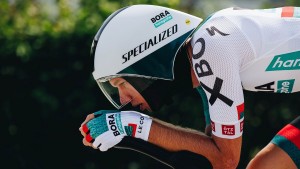Balaclavas and impossible helmets, the latest technology to save tenths of a second
The importance of aerodynamics in today's competitive cycling has its maximum expression in time trials, where solutions to shave seconds off the clock are becoming more and more spectacular and eye-catching, especially in terms of aerodynamic helmets.
 When aesthetics and aerodynamics don't go hand in hand
When aesthetics and aerodynamics don't go hand in hand
In recent days, those of us who follow cycling races have been able to enjoy two time trials, the individual time trial that opened the competition in Tirreno-Adriatico and the innovative team race proposed by the organization of Paris-Nice. A discipline quite neglected in recent years and that, however, represents the maximum expression of the cyclist's effort and where the influence of equipment in the final result goes up many levels compared to the usual races.
With bikes constrained in their development by the rules set by the UCI, despite the greater permissiveness granted to brands in recent years, teams are trying to improve the aerodynamics of the rider himself, which, let's not forget, accounts for 80% of the resistance offered to the forward movement of the bike.

RECOMENDADO

How many calories are burned when cycling

What is heart rate variability and how does it affect the cyclist?

Change wheels if you want to transform your bike's behavior

What bike size do you need? Here's how to find out

How does age affect performance and recovery?

10 tips for safer and faster downhills on road bikes
In addition to intense winter work to achieve the position with the lowest aerodynamic coefficient, which in turn allows the full power contained in the rider's legs to be developed, there are also improvements in the time trial suits with extremely aerodynamic fabrics and tight-fitting cuts and, what is undoubtedly the most striking aspect, the aerodynamic helmet, one of the elements that most influences the improvement of aerodynamics.
The aerodynamic helmet serves not only to provide a profiled surface to penetrate the wind, but also to guide the airflow around it so that it remains attached to the rider's body as progressively as possible to avoid generating turbulence that increases aerodynamic drag as much as possible.
Traditionally, this was achieved with helmets in the classic teardrop shape that elongated to follow the line of the rider's back. However, the limitation at that time in analyzing wind penetration showed that, as soon as the head moved from this ideal position or the side wind came into play, its effectiveness dropped significantly.
Head fairings
This is how one could describe the evolution of aerodynamic time trial helmets in the last two years. A trend that was inaugurated years ago by POC with the launch of its Tempor model, a helmet that ended up being dropped from its catalog at a time when the trend was for rounded models, and which has returned to the forefront with the new trend of integrating the helmet into the rider's body as much as possible.
The Tempor, used by the EF Education-EasyPost riders who, by the way, are making a remarkable start to the season, broke with everything known at the time with a design whose profile grew in width to more efficiently guide the flow to the rider's shoulders.

Last season, the development of time trial helmets returned to the limelight with the arrival of the Specialized S-Works TT5 helmet, not only because of the striking balaclava it incorporates, intended on the one hand to make the rider's face more aerodynamic, especially with regard to the ears, but also to achieve a clean flow of ventilation air inside the helmet, without the turbulence generated by the rider's hair. It also helps the rider to keep his head in the most aerodynamic position. In addition, as in the case of the POC, the structure is wider and the sides are lowered further down to achieve the same objective, greater integration with the rider's shoulders for a smoother transition.
A different approach is that of Kask with the new helmet used by the INEOS Grenadiers cyclists. A helmet that also grows in width though and, while maintaining a compact and rounded design, also seeks to properly guide airflow to the rider's shoulders but using a different method. It achieves this thanks to its huge visor that has small deflector flaps for this purpose.
 The latest to join this new trend of radical helmets is the Sweet Protection Redeemer 2Vi Mips that uses the Uno-X. This helmet is much more prominent at the front and requires a more aligned head and neck position from the rider. Its main innovation is found in this front part where there is a generous air inlet whose mission is not ventilation but aerodynamic, accelerating the flow of air that goes inside to direct it properly to the exit of the same towards the shoulders.
The latest to join this new trend of radical helmets is the Sweet Protection Redeemer 2Vi Mips that uses the Uno-X. This helmet is much more prominent at the front and requires a more aligned head and neck position from the rider. Its main innovation is found in this front part where there is a generous air inlet whose mission is not ventilation but aerodynamic, accelerating the flow of air that goes inside to direct it properly to the exit of the same towards the shoulders.
Details of equipment that can make the difference in a discipline as technological as time trial and that contrasts with the more or less traditional design models that we still find in many teams of the highest category.
 When aesthetics and aerodynamics don't go hand in hand
When aesthetics and aerodynamics don't go hand in hand